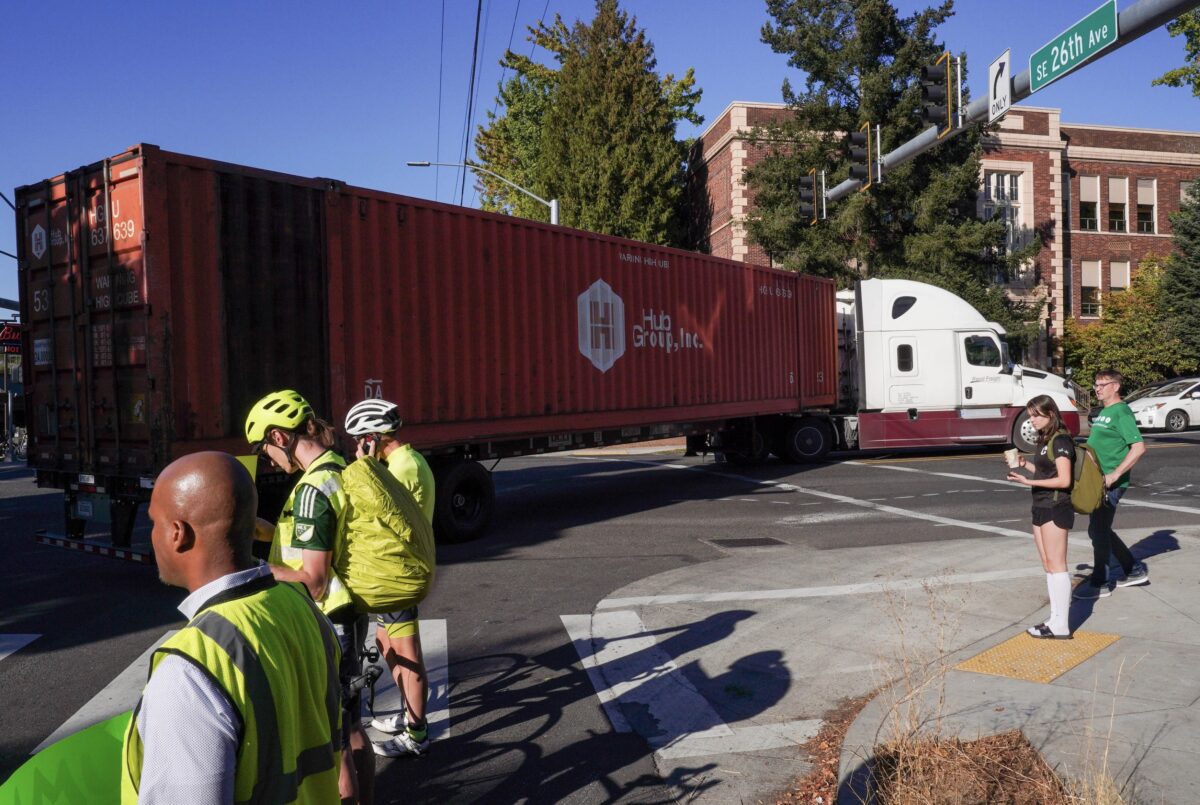
The Portland Bureau of Transportation will redirect freight truck traffic off of SE 26th Avenue south of Powell Blvd. The plans were announced this morning at the monthly meeting of the PBOT Freight Advisory Committee.
It’s not the outright truck ban requested by some, but it could significantly reduce dangerous traffic at the notorious intersection.
PBOT Transportation Planner Zef Wagner told members of the committee that he and his team looked more closely into the issue following the traffic collision that killed Sarah Pliner on October 4th. Pliner was killed when she came into contact with a semi-truck driver’s trailer as he made a sweeping right turn from 26th onto Powell. “We found that 26th Avenue at Powell is incorrectly classified as a freight district street when it’s not actually adjacent to a freight district,” Wagner said. That fact gives PBOT the ability to change truck routing in the area.
Currently there are “Truck Route” signs on SE Gladstone telling eastbound drivers they can go either direction on 26th to access the interstate freeway system via Powell Blvd. Wagner said PBOT will change those signs and direct truck drivers south on 26th only, and then use Holgate to reach the freeways.
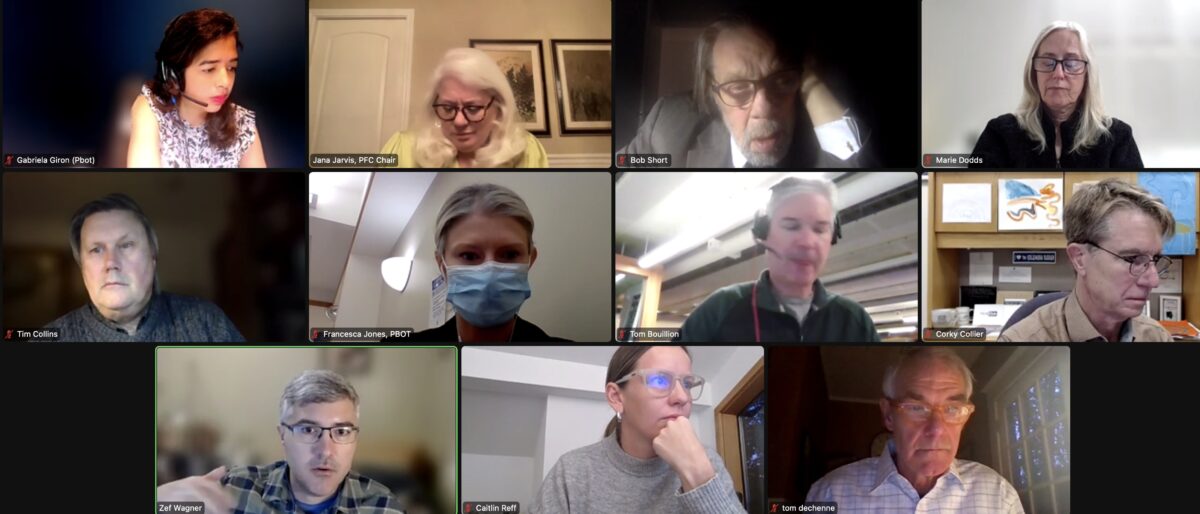
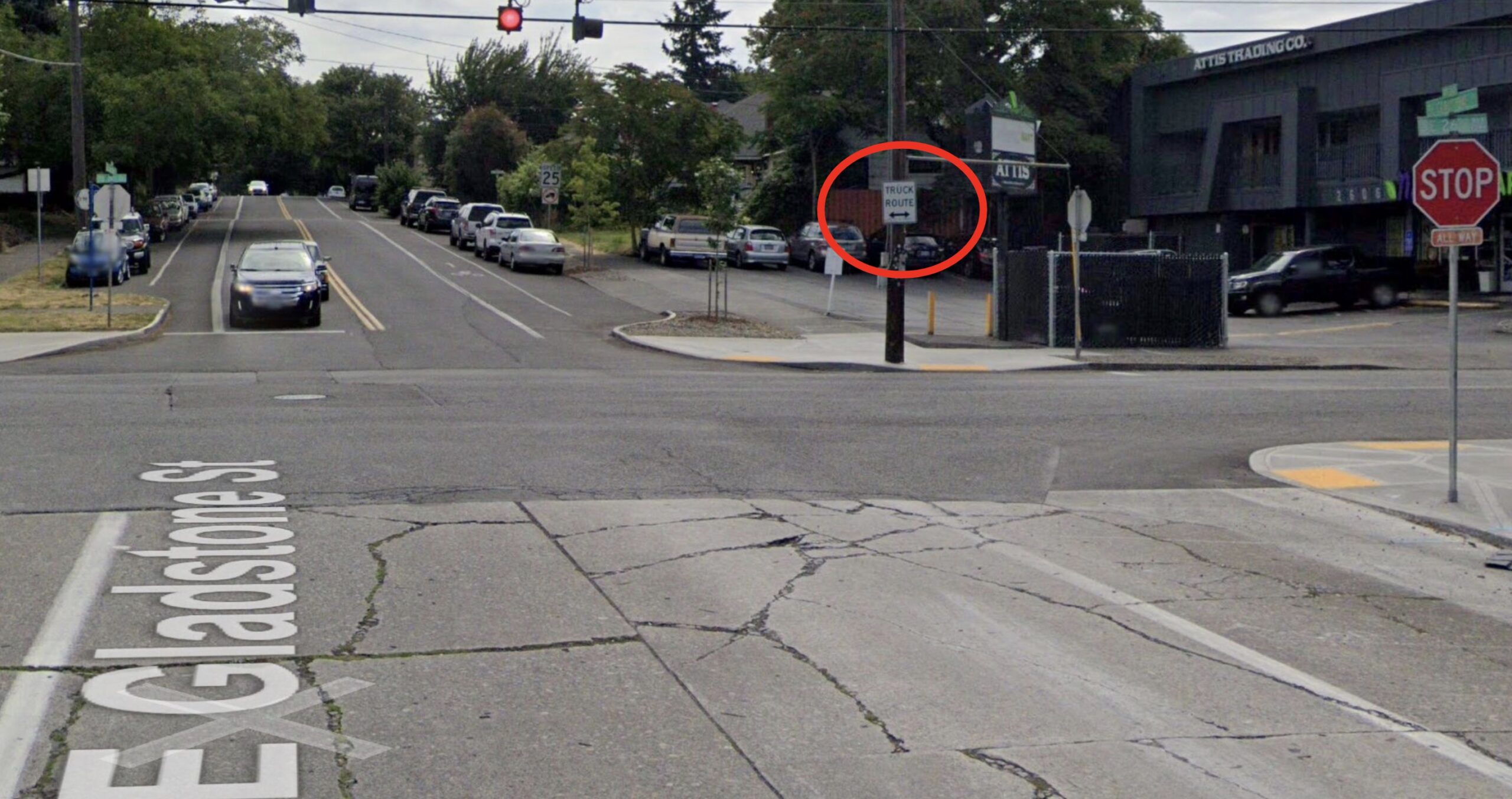
“We want to encourage them to use a more appropriate route,” Wagner said. And in the longer term, PBOT wants to find a direct connection between the Annex Yard and Holgate so they can avoid 26th, a narrow residential streets, completely.
Oregon Trucking Associations President Jana Jarvis was first to speak up with a question for Wagner about the plan. She was concerned what nearby freight companies would think and wanted to make sure PBOT talks to them before making any changes. “That has been identified as a freight route for a number of years and the bicycle route was not on 26th,” Jarvis said.
Later in the meeting, PBOT Planner Nubia Milpas Martinez spoke up to say she had just received a message and was asked to share it with the committee. It was from PBOT Bike Coordinator Roger Geller. Turns out he’d been listening to the meeting and heard Jarvis claim that 26th is not a bike route. “He wanted to mention that 26th Avenue is classified as a city bikeway and has been designated as such since 1990,” Milpas Martinez said. “It was one of the earliest striped bike lanes. He just wanted to make that known.”
“There has to be some agreement that the City of Portland is going to protect these freight routes because you’ve got to be able to move freight in and out of these locations.”
– Jana Jarvis, Oregon Trucking Associations
To Jarvis’ point, Wagner said talks with business owners are in the works and PBOT engineers have already done truck traffic counts and observations in the area. Given that, they feel confident that there are enough other streets to handle the UP rail yard traffic (which Wagner noted has created, “vastly increased activity in recent years”), but there will still be meetings and more analysis before the changes are made.
Jarvis still expressed concerns that a freight route might be taken off the table. “The larger issue is the fact that as traditional freight routes get gentrified, that puts pressure on the city and on the industry. There has to be some agreement upfront,” Jarvis continued, “That the City of Portland is going to protect these freight routes because you’ve got to be able to move freight in and out of these locations.”
Wagner reassured Jarvis that truck operators will still be able to use 26th between Gladstone and Powell, but the city’s effort will be to strongly encourage them to go elsewhere.
“This is more about finding the more appropriate route,” Wagner said. “We’re not saying don’t use the street at all. A lot of people in the neighborhood would like us to like ban trucks from all 26th Avenue. They’ve been saying that for years, and we’re not going to do that because they just don’t have another good route.”
That means some freight truck traffic will continue to use the problematic southeast corner of 26th and Powell.
In a BikePortland story last month, the owner of a trucking company and a retired ODOT freight division manager told us that corner is inherently risky for people on the street because of the length and turning movements of large trucks.


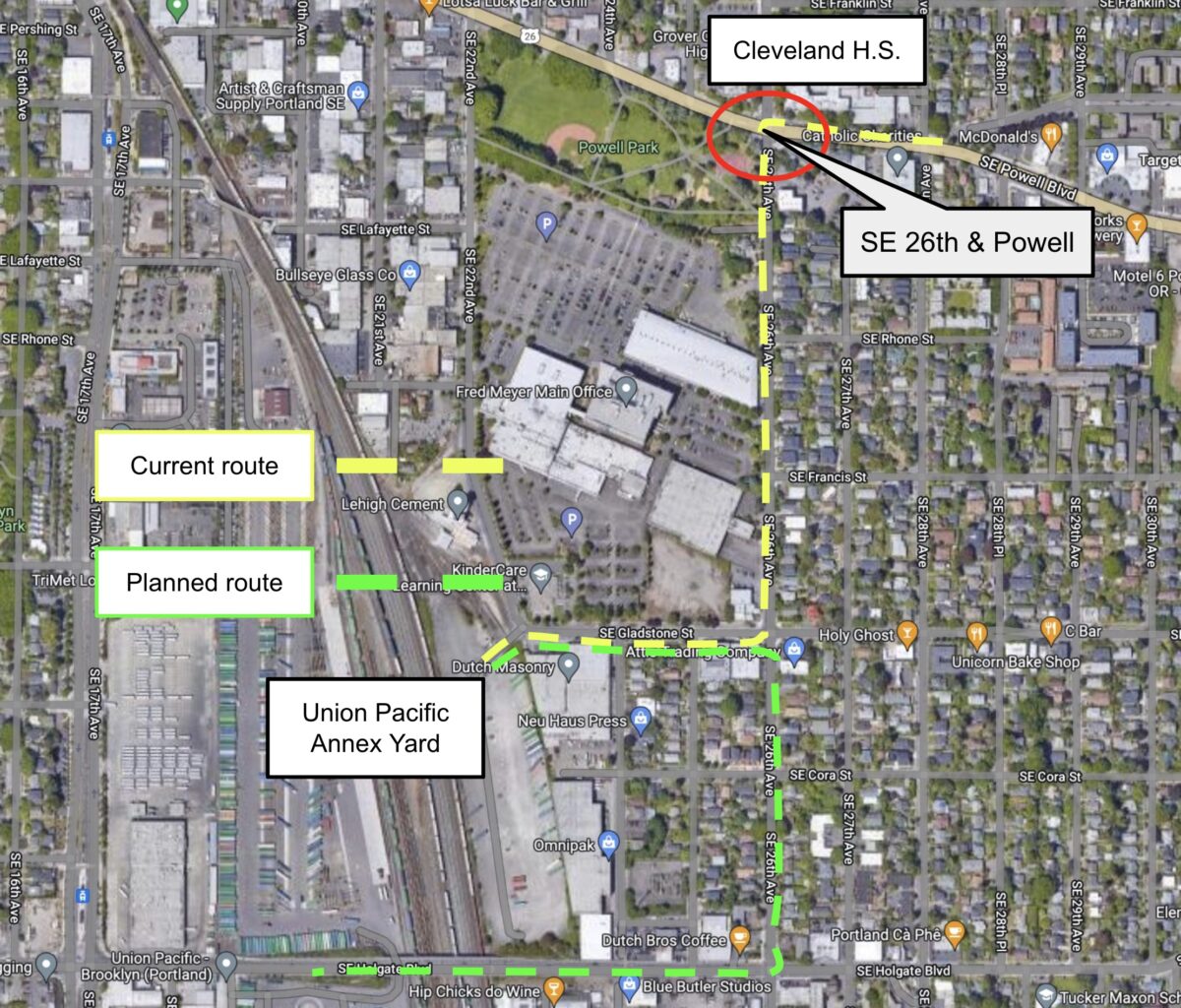



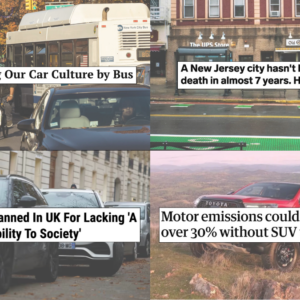
Thanks for reading.
BikePortland has served this community with independent community journalism since 2005. We rely on subscriptions from readers like you to survive. Your financial support is vital in keeping this valuable resource alive and well.
Please subscribe today to strengthen and expand our work.
Naïve question: does it matter what the signs say? That is, is it regulatory such that freight is supposed to follow the directions, or are drivers free to determine their own route? If it’s the latter, how big of a difference would this even make?
PBOT’s Wagner makes it clear in the story that the changes would be limited to signage and that they won’t be legally binding. So how much difference the signs makes remains to be seen. However, I think the larger piece here are the meetings between PBOT and freight-oriented companies like Fred Meyer, UP Yard, and so on. They need to be good partners w PBOT for a lot of reasons, so when PBOT sits down and says, “hey, we need you to do X”, they have reason to listen. They are likely to say, “OK, fine. But we need you to do X” and that’s where the rubber often hits the road.
Thank you for the added clarity.
So frustrating. “they have reason to listen”. Why do they have any choice to listen or not? It’s the “Portland Bureau of Transportation”, that seems like they’re the boss. This making nice with business interests is what gets us turning bike lanes back into parking and driving lanes like in a recent story. I know they’re different things but I don’t feel like PBOT should be (or legally is) on a peer type of relationship with local businesses.
When we first discussed redesigning outer Powell with ODOT in 2010, they pointed out that established freight companies with multi-state operations were required by their insurers to use “US Highway” routes whenever possible, then state routes, and finally urban-designated signed freight routes (outer Powell has all 3 designations), or else lose their load and crash coverage. Freelancers of course have other rules, but if they are insured (and they usually are required to be), they too tend to follow these designated routes. Naturally there will be some a–holes who will ignore the signage, just as some car drivers speed and downtown Portland pedestrians cross against the light, but overall there should be better compliance.
If you want to measure how effective these designations are, sometime count the number of big semis on outer Powell which has one lane in each direction, versus outer Division with two lanes in each direction. When I lived in East Portland through 2015, outer Powell had a lot more truck traffic in spite of the smaller roadway – Division was mostly cars.
GPS doesn’t even know those signs exist. And I can almost guarantee if a truck driver has a choice, they will follow their GPS directions and ignore the signs.
I don’t think that’s really true. If a truck driver is using a “no trucks” street and then gets in a crash, they could be held liable and they might not get insurance coverage. Truck drivers care quite a bit about liability which is why they tend to stick to highways and other major freight routes.
From the article and comments above–the signs suggest a route. They aren’t legally binding, and don’t prohibit trucks from using other routes. They don’t say or mean “NO TRUCKS”.
It’s weird that people are celebrating the preservation of 26th as a freight route in these comments.
Why is that a reply to my comment? I’m not celebrating it. I’m saying only what I said–that the signs suggest a route, but don’t prohibit anything. If anything, that’s an argument that the signs are weak.
OK (answering my own question about your reply to my comment) I’m now reading it and–assuming I’m reading it correctly–agreeing with you. It IS weird that signage changes that preserve 26th as a freight route (which they do) are getting praise.
They come through my neighborhood all the time despite the ‘not a truck route’ or ‘no trucks allowed’ signs or whatever they say.
The last driver I confronted when he had to get out of his truck cab to clear branches he broke off a neighbor’s tree actually said he was following the ‘truck GPS’. This is not irrelevant to this discussion since I live close to SE 26th and Stephens. That was a couple of weeks ago but it happens all the time.
They are not thinking about liability, they are thinking about their destination and the shortest, quickest route to get there, regardless of how it is signed or designated, and the GPS is clueless as to liability.
Insane that they don’t mention anything about how Gladstone between the Annex and 26th is a Safe Route to School and a city bikeway. The city doing anything other than closing the annex completely is a total abandonment of safety for every vulnerable road user. Elementary students from the Brooklyn Neighborhood use Gladstone to get to school at Grout, and it’s the only bikeway going southeast from Brooklyn as well.
The annex does not need to exist to fully serve the rail yard, they have full access to the entire regular freight transport network via Holgate and Harold entrances. They have plenty of other routes – and just elect not to take them due to how UP choses to run the yard operations. It’s insane to suggest that we just have to keep that area of the yard open – it doesn’t serve a single industrial client directly anymore and is only used to shortcut trucks onto Powell (via 26th and Gladstone).
I bike my kids from FoPo to Winterhaven School in Brooklyn along this “Safe Route to School.” There are some sketchy intersections along the whole trip, but the entire stretch from 26th and Gladstone to the Lafayette elevator is easily the most harrowing. The trucks going in and out of the annex are a big contributor to that, but it’s all made worse with how wide and straight the road is in order to accommodate the trucks. Car drivers race down these streets like it’s a freeway.
Yeah things are definitely made much worse by Winterhaven being a STEAM school bringing in more folks from outside the neighborhood (to be clear, I like that Winterhaven is a STEAM focused school, but of course it makes more travel on neighborhood streets – including the ones in question here). PBOT is really playing with fire by doing nothing with Gladstone west of 26th, and it’s only a matter of time before someone gets seriously hurt. Incredibly frustrating to see capitulation to entirely self-inflicted freight considerations.
And how would you propose the City force UP to abandon the Annex? I don’t see how there is any legal way to do that.
As stated above, if they remove designations like “freight route” and “highway” from roads, then basically the freight trucks lose lots of their insurance.
Sure, they could do that. But if PBOT removed all possible freight routes from a major intermodal facility like the UP Annex, they would sue PBOT and would win. If you fully cut off access to an existing business that is called a “taking” and is illegal.
But the annex is not “a major intermodal facility”. It’s a gravel parking lot that is fully disconnected from the rest of the yard used for overflow parking/storage. Every single intermodal container carried there has to be driven there from the main part of the yard via Holgate, 26th, and Gladstone, and then out via Gladstone and 26th to Powell or Holgate.
UP takes advantage of the area by the annex being designated as a “freight district area” by PBOT to use a gravel lot much more intensively than I think is intended. PBOT can and should act to protect the vulnerable road users who rely on the streets nearby, but also to protect the interests of the other local light industrial uses in the area. All the intermodal trailers moving in and out on the roads really degrade their condition, and that has negative consequences for them as well.
It is a facility that the UPRR would describe as essential for them to operate their business, a business that has been here since before any other use was around. They would make that argument in federal court as they are federally regulated and protected as an essential service to the operation of our national economy. As noted above, the city would not win that suit, which is why they have not tried to close the annex.
Frankly that’s not entirely accurate. Brooklyn was a residential addition roughly at the same time the East Side Company built the original rail line through the area. Certainly Southern Pacific building it’s steam locomotive shops at Brooklyn played a huge role in the area becoming a neighborhood – but it’s not as straightforward as that either (other industrial uses, and the streetcar shops at 17th and Center were major area employers too). When Union Pacific decided to make Brooklyn their primary intermodal facility (rather than Albina, or Barnes yard) sometime in the 2000s/2010s it wasn’t like they didn’t have other choices.
Is a gravel parking lot disconnected from the rest of the yard really “essential” to the national economy? Does UPRR get to decide that by fiat? I would think any critical analysis of the yard operations would point to the use of the annex as incredibly inefficient at best. The annex is a residual former direct rail client (based on what I can discern from older maps of the area) that has been converted to its current use somewhat recently. Just because a railroad is “essential” does not mean they should get to operate with impunity, however they please.
PBOT not acting to close the annex (or even to reduce its impact) is exactly the sort of surrender of responsibility that is unacceptable. UPRR will continue to walk all over us if they are allowed to, and I expect my government agencies to act in a way that protects me from them. Not the other way around, like the freight committee proposes.
Judging by the totality of your comments on this thread, it appears very likely that you are shilling for the trucking industry my friend.
Zoning, they could zone the annex as something else because it “no longer fits the neighborhood”. Happens to other uses all the time. History has no deterrent against changing neighborhoods.
HAHA, if this was feasible, there would be no rail yards within any city limits. I don’t think people understand or are unwilling to understand the level of protection and support the railroad operators receive from the federal government.
Why don’t trucks leaving the annex go north on SE 22nd and then turn right on SE Powell? It seems more direct. Con: part of it is a greenway. But so is SE Gladstone.
I think it’s probably because there’s no stoplight at 22nd. The light at 21st is maybe hard to get to, a few tight turns would be needed afterwords/beforehand
Truckers will continue to use 26th Avenue because it is most efficient for their movements. That’s pretty much the same reason that I choose to use 26th Avenue on my bike.
Look at where the transportation system users’ (pedestrians, bicyclists, transit users, motorists and truckers) entire trip. If you look at the map of the “planned route,” you will see that it doesn’t lead the trucker to anywhere. If a bike path detour were crafted with the same care, we’d all be outraged.
It’s going to take lots more than a meeting by well-meaning people to develop a good solution.
Holgate is nowhere? Ok.
Either trucks can use SE 26th between Gladstone and Powell, or not. PBOT and Jarvis can’t have it both ways.
“PBOT and Jarvis can’t have it both ways.”
And yet… I somehow think they will.
Is. “Safe washing” a term? City of Portland pats itself on the back for removing Freight Route signs, but keeps the Freight Route designation.
The primacy of Freight remains undiluted . How is it possible that Portland can find new and bigger ways to suck?
I think it depends on whether “safe washing” is viewed through the “equity lens.” Maybe another task force and a study is in order.
This doesn’t seem like it will do much – those arrows don’t even point in remotely the same direction. Maybe someone could explain how this is supposed to work
That’s a photo of the existing sign, not the proposed change.
Looks like if a person wants government to address a serious problem for active transportation users the best hack is to get out there and be killed.
Seems to work at a rate of about 60-70%.
This must be one of those 30-40% cases then, because this problem has not been addressed.
Really, Jarvis? Is that the larger issue? Not the cyclist that got smashed in front of a school by a truck that under reasonable regulations would have no business being anywhere near that area? Seems like that’s the larger issue.
He must think that cars are people and they get priced out of the neighborhood 😉
wtf, did they just say freight routes get gentrified? That’s the larger issue? The poor oppressed freight routes? Ok I’ve heard it all now
“…and then use Holgate to reach the freeways.”
I’m glad to see that PBOT acknowledges (after another death) that 26th and Powell was a set up for fatal tractor-trailer right hooks, and is directing trucks away from performing that maneuver at that intersection. But pushing the freeway-bound semis onto Holgate seems like a horrible idea. Powell has two lanes each direction and room for semis. Enforce a 30 mph speed limit (or lower), install more cameras, do whatever it takes with infrastructure to slow drivers the f*** down. But directing the semis onto a single lane road that’s actually used by cyclist between 26th and the I-205 bike path is a horrible idea.
The main freight route for the Brooklyn Yard area is 99E/McLaughlin Blvd. Holgate would be used to travel west to access 99E.
That makes more sense. However (and someone please correct me if I’m wrong) wasn’t Sarah Pliner killed by a truck making a right turn (therefore heading east) from 26th onto Powell (just like the truck in the photo in the header)? Where are those trucks headed and if they’re going east to 205 how does PBOT’s plan affect that?
They’re talking about the four-lane section of Holgate west of 26th Ave, heading to McLoughlin Blvd, not the two-lane section east of 26th Ave.
SE Holgate becomes a single lane in both directions at SE 29th. Trucks would be turning right onto SE Holgate from SE 26th and heading west to SE 17fth to access 99 East or West.
I think you’ve confused the I-205 bike path with the Springwater Corridor. A bicyclist using SE Holgate to get to the Oaks Bottom Refuge parking lot & path to the SWC at SE Mitchell & SE Milwaukee can ride the wide sidewalk to on SE Holgate from the SE 28th bike route to SE 17th and then bike across 99 E/W to SE Mitchell.
Also, there’s no freeway on-ramp from Holgate. Is PBOT going to direct trucks back to Powell and the onramps via 92nd, where they’ll be making a right turn (and interacting with PPS high school students from the Marshall campus)?
Good, I t’s about time! Those trucks never should have been allowed anywhere near the school. When I went over there to get a better look at that intersection, I watched a truck turn from Powell onto 26th. It was turning wide. The trailer sort of tipped a little as it turned.
If PBOT were to ban semi-trailers on 26th, Union Pacific could just re-arrange their operations to route all Brooklyn Terminal truck traffic through the main entrance on Holgate. Of course PBOT won’t do that because large corporate landowners mustn’t be inconvenienced for the sake of mere human lives.
Why not make a freight ramp to Holgate, west of SE24th, including traffic lights to stop cars and pedestrians while a freight truck is coming through?
That would be a great solution!
It could be built directly between the UP Annex Yard lot & SE Holgate. There’s nothing between the the two except some bushes and trash.
It’s amazing to me that even a death – a DEAD PERSON – is not enough to keep Jana from advocating for trucks to go wherever they want on Portland’s city streets!
It’s like she’s saying, “We will allow not ONE SINGLE LIMITATION in our quest to move freight in the way that is least burdensome to us.” It’s really not a good look.
Sometimes 18-wheelers take Barbur and I ride in the bike lane about two feet from the wheels of these huge trucks. It’s like playing Russian roulette, as I hope a blowout or a stick or a slippery patch doesn’t send me underneath one of the 18 wheels.
This is a crowded city! Trucks need to move in the way that is safest for EVERYONE, not just the most convenient way for the driver or the trucking company.
I’ve said it before and I’ll say it again, every transportation organization is loathe to put any restrictions on the most dangerous vehicles that travel our public roads. Instead they want to tell the safest, quietest, non-polluting, most vulnerable road users what routes they can take and where they can or should cross streets,
Positive development, now if we could just get demoting motor vehicle traffic modes every time a vulnerable user was killed or crippled we might start seeing some progress towards Vision Zero in this town.